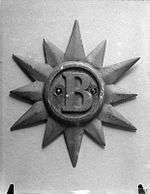HMS Brilliant (1891)
HMS Brilliant was an Apollo-class cruiser of the British Royal Navy which served from 1893 to 1918 in various colonial posts and off the British Isles as a hastily converted minelayer during the First World War.
.jpg) | |
| History | |
|---|---|
| Name: | HMS Brilliant |
| Builder: | Sheerness Dockyard |
| Laid down: | 1890 |
| Launched: | 24 June 1891[1] |
| Commissioned: | 1893 |
| Honours and awards: | ZEEBRUGGE AND OSTEND 1918 |
| Fate: | Scuttled as blockship, 23 April 1918 |
| Badge: |
 Ship's badge of HMS Brilliant (IWM Q20182) |
| General characteristics | |
| Class and type: | Apollo-class cruiser |
| Displacement: | 3,600 tons[1] |
| Length: | 314 ft (95.7 m) |
| Beam: | 43.5 ft (13.3 m) |
| Draught: | 17.5 ft (5.3 m) |
| Speed: | 19.75 knots (36.58 km/h) |
| Complement: | 273 to 300 (Officers and Men) |
| Armament: |
|
Operational history
Brilliant was commissioned at Portsmouth on 1 October 1901 by Captain Hugh Pigot Williams, for service with the Cruiser Squadron.[3] In May 1902 she was taken into Portsmouth for a refit, and on 16 August that year she took part in the fleet review held at Spithead for the coronation of King Edward VII.[4] The following month she visited the Aegean Sea with other ships of her squadron for combined manoeuvres with the Mediterranean Fleet, returning to Portsmouth in October.[5]
First World War
On 23 October 1914, Brilliant, together with sister ship Sirius, and several sloops and destroyers, shelled German troops on the Belgian coast. On 28 October, Brilliant was on similar duty when she was hit by German return fire, killing one of her crew and wounding several more.[6] On 11 November 1914 the torpedo-gunboat Niger was torpedoed and sunk in the Downs by the German submarine U-12. As a result, as Dover was not considered secure against submarine attack, Admiral Horace Hood, commander of the Dover Patrol and senior officer at the port of Dover, ordered Brilliant and Sirius to Sheerness to avoid the submarine hazard.[7] While based at Sheerness, Brilliant and Sirius served as guardships against possible German attack.[8]
In June 1915, Brilliant served as guardship on the Tyne. On the night of 15/16 June 1915, the German airship L10 attacked targets on the Tyne, bombing Jarrow, Wallsend and South Shields. 18 were killed and 72 wounded by L10's bombs. Brilliant fired at L10 but the German airship was undamaged.[9][10]
In July 1917 Brilliant was based at Lerwick in Shetland as a depot ship for the trawlers and patrol boats of the Auxiliary Patrol.[11]
Wreck
In April 1918, Brilliant was deliberately scuttled in the mouth of Ostend harbour in Belgium during the failed First Ostend Raid. This operation was intended to block the harbour mouth and prevent the transit of German U-boats and other raiding craft from Bruges to the North Sea. German countermeasures were, however, too effective, and Brilliant and fellow blockship HMS Sirius were eventually destroyed by their crews outside the harbour mouth after running aground on a sandbank. The wrecks were broken up postwar.
References
- The Times (London), Thursday, 25 June 1891, p.7
- Admiral Percy Scott quotes 6 x 4.7 inch guns on sister ship HMS Scylla in 1899. "Fifty Years in the Royal Navy" published 1919, page 88
- "Naval & Military intelligence". The Times (36575). London. 2 October 1901. p. 10.
- "Naval Review at Spithead". The Times (36847). London. 15 August 1902. p. 5.
- "Naval & Military intelligence". The Times (36902). London. 18 October 1902. p. 9.
- Corbett 1920, pp. 228, 232.
- NSM 28 1925, pp. 34–35.
- NSM 28 1925, p. 45.
- NSM 29 1925, pp. 237–238.
- Cole & Cheesman 1984, pp. 62–63.
- NSM 35 1939, p. 302.
Publications
- Cole, Christopher; Cheesman, E. F. (1984). The Air Defence of Britain 1914–1918. London: Putnam. ISBN 0-370-30538-8.CS1 maint: ref=harv (link)
- Colledge, J. J.; Warlow, Ben (2006) [1969]. Ships of the Royal Navy: The Complete Record of all Fighting Ships of the Royal Navy (Rev. ed.). London: Chatham Publishing. ISBN 978-1-86176-281-8.
- Corbett, Julian S. (1920). Naval Operations: From the Outbreak of War to the Battle of the Falklands December 1914. History of the Great War. I. London: Longmans, Green and Co.CS1 maint: ref=harv (link)
- Gardiner, Robert; Gray, Randal, eds. (1985). Conway's All The World's Fighting Ships 1906–1921. London: Conway Maritime Press. ISBN 0-85177-245-5.
- Monograph No. 28: Home Waters Part III: From November 1914 to the end of January 1915 (PDF). Naval Staff Monographs (Historical). XII. Naval Staff, Training and Staff Duties Division. 1925.
- Monograph No. 29: Home Waters Part IV: From February 1915 to July 1915 (PDF). Naval Staff Monographs (Historical). XIII. Naval Staff, Training and Staff Duties Division. 1925.
- Monograph No. 35: Home Waters Part IX: 1st May 1917 to 31st July 1917 (PDF). Naval Staff Monographs (Historical). XIX. Naval Staff, Training and Staff Duties Division. 1939.
| Wikimedia Commons has media related to Apollo class cruisers. |